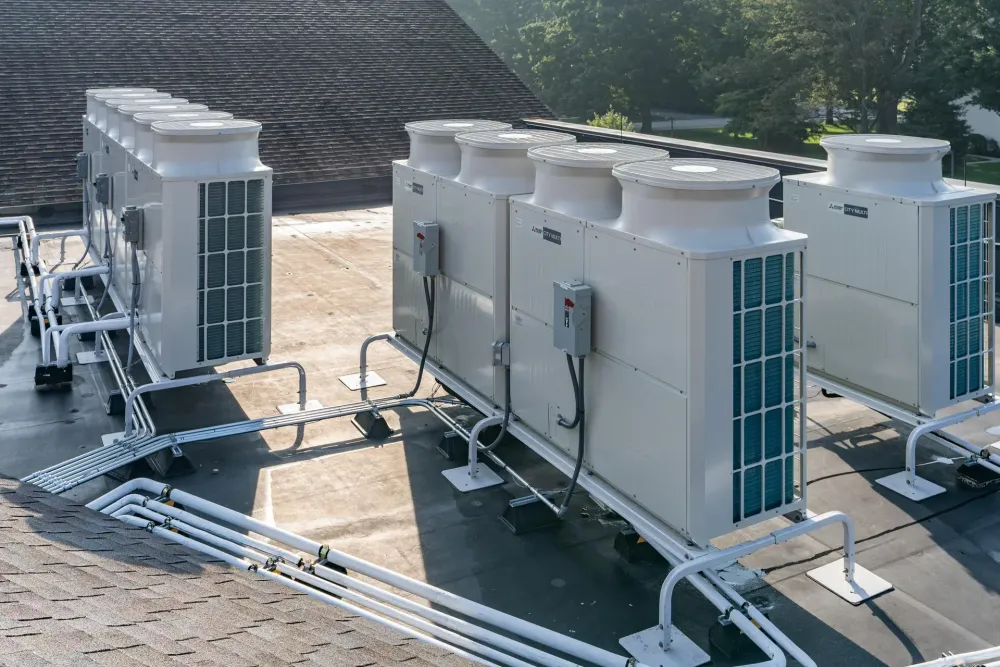All-electric variable refrigerant flow (VRF) heat pump and heat recovery systems help reduce energy costs while freeing up space for revenue-generating amenities. Building owners, operators and developers are increasingly leaning toward high-performing, energy-efficient VRF heat pump systems, especially with current and upcoming changes in government regulation, legislation and building codes.
VRF zoning solutions are becoming popular for mixed-use facilities, multi-story buildings and hospitality-industry customers, among others, wanting to separate their spaces by zones to control each one’s temperature. Due to their various advantages, VRF has become the fastest-growing segment of the commercial HVAC industry.
Here are four reasons why they have become building owners’ HVAC of choice.
Highly Efficient Operation
Unlike conventional fossil-fuel systems that cycle on and off, a VRF solution can operate continuously at partial load, resulting in higher overall operating efficiency. These systems are efficient because they’re designed to provide the precise amount of cooling or heating needed in a space.
VRF systems use the least amount of energy needed to maintain each zone’s set point, helping to reduce utility bills. As conditioning demands fluctuate with occupancy, activities and outdoor temperatures, the VRF system ramps up and down as needed to keep indoor temperatures steady.
Energy-Saving Heat Recovery
Another way VRF systems can help improve efficiency is through the heat recovery process, which allows for simultaneous heating and cooling. While conventional systems dispose of excess heat captured from the indoor units in cooling mode, a VRF solution redirects the heat to the zones that require heating.
Energy-saving heat exchange is managed through electronic expansion valves and a smart control system that modifies refrigerant flow based on the demands of each indoor unit. The heat recovery system repurposes would-be waste heat into free warmth for the building, reducing the outdoor unit’s energy usage and contributing to operational savings.
Customization and Simplification through Modularity
The modularity of VRF technology allows easy customization and zoning so the system can be tailored to each area in a building. Modularity also enables contractors to install systems floor by floor so developers can defer portions of the total installation cost until tenants sign leases.
The modularity of a VRF system simplifies servicing and maintenance because each indoor unit operates independently. Up to 50 indoor units can connect to a single outdoor unit. So, if one unit experiences an issue, it can be serviced without affecting the rest of the system.
Lighter Equipment, Smaller Footprint and Quieter Operation
VRF systems can help reduce upfront costs as they require less structural support and fewer alterations to building facades. The reduced weight of the outdoor and indoor units makes them easier to transport and handle during installation, often eliminating the need for heavy lifting equipment.
Plus, the smaller footprint and ultra-quiet sound levels make VRF systems an attractive choice for urban high-rises, hotels, libraries, educational systems and other buildings with space constraints and acoustical considerations. For example, hotels often select a compact and unobtrusive-sounding VRF solution to leverage additional space for revenue-generating amenities like rooftop bars, restaurants and pools.
For building occupants, low noise levels support a more productive and enjoyable environment, ensuring minimal disturbance so people can work, rest or do other activities without louder noises made by conventional HVAC systems.
A Superior Heating and Cooling Solution
VRF zoning systems offer numerous benefits that make them an outstanding HVAC solution for commercial and multi-family residential buildings. VRF solutions provide an ideal balance of performance, energy efficiency, space optimization, and cost-effectiveness, making them an attractive choice for modern buildings seeking innovative HVAC solutions.
As the leading provider of VRF zoning systems, Mitsubishi Electric Trane HVAC US (METUS) has the expertise, support infrastructure and product portfolio to optimize heating and cooling in virtually any building, anywhere.









